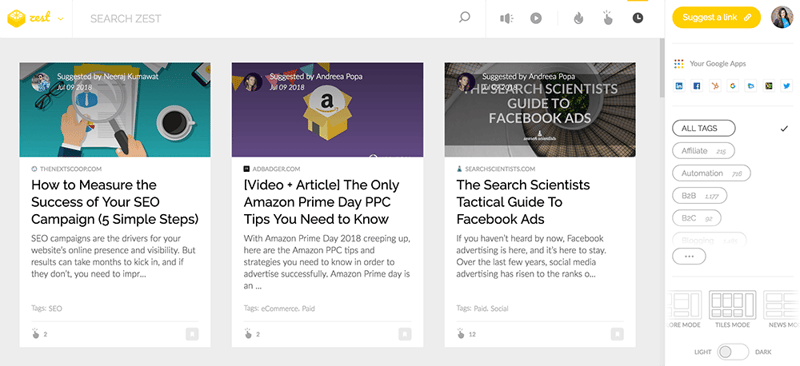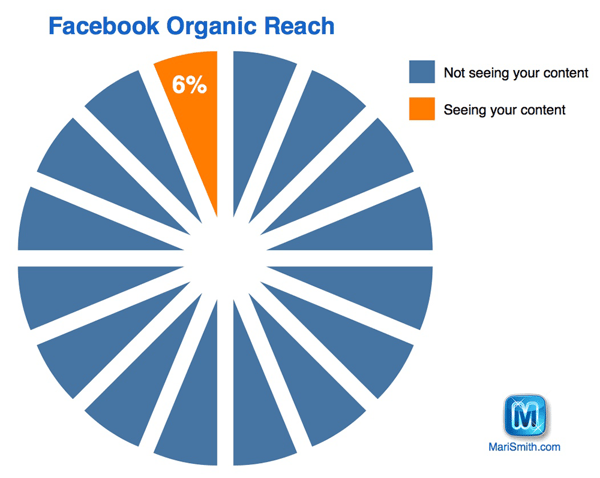There are several times throughout the year where it makes sense to review progress and analyze the effectiveness of your marketing. This might be at the end of the month, end of the quarter, the halfway point, or year-end.
Great marketing professionals know that analysis and reflection are powerful tools to identify what’s working and what’s not. Analysis allows you to identify where you may need to build, clarify, or refine your message. It also provides a framework to identify new opportunities, place bets on strengths, hedge against competition, and mitigate weaknesses.
For example, when we reviewed our marketing, we noticed a new referral source called "Zest.is" - so we investigated and discovered a whole new marketing community for top-notch content. Without this exercise we wouldn't have found this powerful new outlet for content sharing and learning!

This article is designed to help you perform an effective review of your marketing from the halfway point. But it could also be used to analyze and audit your marketing for a campaign, or other significant timeframe.
We’ll walk through the Mid-Year Marketing Analysis, which includes:
- What to look for when reviewing your strategic plan.
- An in-depth look at how to analyze five key areas that generate leads.
- How to tell if your marketing and sales teams are truly in alignment.
- Leveraging customer insights as a way to grow sales.
- Capitalizing on trends, publicity, and other spur-of-the-moment opportunities.
- Developing clear action items based on the information you’ve uncovered.
Step 1: Review Your Strategic Plan
If you have a strategic plan, start here. If not, that should be a conversation to have with your executive team. For now, refer to your marketing plan or the goals or the outcomes you were tasked with as a marketing team. Don't have a marketing plan? No worries. Check out our guide to writing a marketing plan here - there's even a free template!
Now, analyze your progress so far this year relative to the plan.
Start by doing a quick review of the strategic plan and/or marketing plan.
Find the sections where you lay out your objectives and goals. Underline the measurable piece, then dig up the numbers and data relative to each one of those goals
For example, if your goal as a marketing team was to improve top of mind awareness and overall brand reach, you’ll want to examine the success metrics you identified. This may have been brand mentions, PR placement, social media impressions, etc. If your goals were focused on sales, your success metric may be the value of opportunities in the pipeline that were generated or influenced by marketing, etc.
By doing this exercise, marketers may realize that the measuring stick for their goals was unrealistic or completely immeasurable ("get more visibility" without an identified success metric is not measurable!). That happens a lot as well. If it happens to you, consider it an opportunity to get more specific on your goals and metrics for the 2nd half of the year.
Once you have all the numbers you need, copy and paste your objectives/goals into a new document and indicate the status of each: Complete, On Track, or At Risk.
Step 2: Determine Where You’re At
Once you have a new document that lists out all of your goals and objectives as well as status of each, take a moment to calculate how well you’ve performed against those goals so far.
In the chart below, you can see that this company has one goal on track, one complete, and one at risk.

While this is a cut and dry way to look at your success, the next section will really begin to look at how successful specific marketing channels are in moving the needle.
Step 3: Get Specific with Your Review by Asking Questions
The beauty of a review is the opportunity to stop and ask questions. This should be a consistent practice in your marketing efforts, but we often move so quickly that it’s easy to get into a rut of “doing marketing stuff” for the sake of the plan. This is an opportunity to step back and ask critical questions of your marketing and sales efforts.
Below you’ll find a collection of sample questions to ask in your mid-year marketing analysis, broken down by area.
Pro tip: this type of analysis becomes much faster and easier if you're using a platform like HubSpot that has all your sales and marketing data in one place.
Strategic Marketing:
- How is the company doing as a whole?
- What has worked? What hasn’t? Why?
- How closely have we followed the strategic plan and/or marketing plan up to this point?
- What successes have we encountered in Q1 and Q2 that we could build upon?
- In looking at the P’s of marketing – product, place, promotion, price, people, process – which of these are contributing to growth? Which may be limiting the company’s growth?
Sales & Marketing:
- How well are sales and marketing aligned?
- How many marketing qualified leads are you passing to your sales team?
- Why are people choosing NOT to buy from us? Where are we failing to convert? Price, product, timing?
- Are customers or clients coming from any surprising sources? Is it anything you can duplicate?
- What is the path customers followed to purchase from you? Are they following the laid-out customer journey? Why or why not?
- How can marketing help sales better qualify leads?
Tactics/Specific Channels:
- Is one channel working better than another?
- How well is your website doing at generating leads?
- How much PR coverage did you generate in Q1 and Q2? Can you link that to any specific opportunities or sales?
- Does it make sense to adjust ad buys?
- Have you done A/B Testing?
- Do you need to STOP using one specific channel because the strategy isn’t working? Or the work put into it isn’t worth the value of the exposure/leads/reach gained?
- Are customers asking for any new services/features/etc.?
- How many referrals are we generating? Could we ask for more referrals in Q3 and Q4?
- What do your social reviews look like on Facebook, Google, and/or Yelp?
- What are people saying about your brand?
Content:
- What’s your content mix? Is it diverse enough?
- Where do viewers drop off when it comes to your videos?
- Could you slice your content down to where viewership lags or edit out the places where they drop?
- How could you better lead people to content that is working?
- Are there marketing pieces in your mix that could be working harder for you?
- How can you repurpose your content and save time?
- Are your marketing pieces on-brand and enhancing your perception in front of your key targets?
- Are there customer testimonials you should be highlighting?
- What success stories should we turn into case studies and/or testimonials?
- What other types of social proof do you need to gather in Q3 and Q4? Stats? Customer logos? PR credibility?
Step 4: Leverage Customer Insights
Customers are at the heart of your marketing efforts. When is the last time you talked with them to find out what they want, know, read, or desire? Savvy CEOs and founders like Apple’s Steve Jobs or Starbucks’ Howard Schultz agree that customer insights are gold.

While this step may take a bit longer, customer insights are far too valuable to pass over.
Take the time to tag along to a few sales meetings or listen to sales calls. Review customer data, surveys, and feedback from the sales team who spends much of their time catering to customers. Get feedback from the customer service department.
If all else fails, aim to have at least a handful of conversations with your best customers. You may also want to see if you can talk to prospective customers who DIDN’T buy.
Step 5: Review trends and look to the future
Trends and the current state of consumer behavior is something that must be accounted for in the mid-year review. Things in the marketplace can change very quickly and a tactic that was hot in Q1 may be losing steam in Q3. Or, there may be a financial crisis on the horizon and your prospective customers are battling fear at a high level.
In thinking about the future, consider the following questions relative to your marketing efforts:
- What trends are affecting how my customers live their lives? Or how they do business?
- How will B2B or B2C communication change in the next 6-12 months?
- What strategies are my competitors using? Do we need to adjust our strategies, tactics, products, services, or message to compete at a higher level?
- Was there anything that happened this year that caught you off guard? How could you be better prepared for these types of last-minute scenarios in the future?
- What type of structure do you need to be able to capitalize on real-time opportunities on social or digital media?
- What type of talent will you need (in-house or outsourced) to carry out your goals for Q3 and beyond?
- Are there any changes coming to digital platforms that will affect your strategy for the 2nd half of the year?
For example, the decline in organic reach of Facebook is one trend that continues to affect social media marketing, as shown by this graphic from Facebook expert Mari Smith:

Step 6: Develop clear action items based on the review
For the purposes of this article, we can’t tell you specifically what to do because each company will have different outcomes from their mid-year marketing audit. The important thing is to communicate this with your team and build a plan to address the areas that need work.
If all of your goals are on track, fabulous! Maybe you need to put some stretch goals in place and really push things forward. If you’re way off track, you may want to reexamine your resources and scale back efforts to focus only on a few programs that are well-executed.
Analysis is the first step. Doing something with the information is where the gold lies!
Conclusion:
When it comes down to it, doing a review of your marketing, especially halfway through the year, is the best way to make sure all the pieces of your strategy are in place and working the way you intended them to.
Remember, marketing blends art and science!
As creative as your deliverables are, the review is a chance to see if they’re really working. This exercise may give you the chance to reallocate your budget. It also has the potential to save you time!
This could mean the difference between falling short of accomplishing your goals in the 3rd and 4th quarter or nailing everything you set out to do in your marketing plan this year.
As we mentioned earlier, a marketing audit becomes a lot easier when you manage all your marketing and sales efforts from a single platform. There are some great options out there, but our favorite is HubSpot. If you're considering HubSpot, you'll want to read this guide first.
Are there specific areas of your marketing that you’d like to review that we didn’t include?
Drop us a note. We can always add to this checklist!



